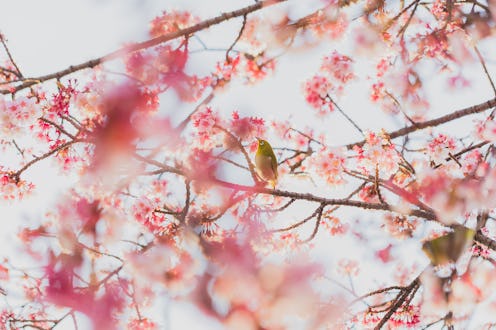
Judging by the colorful blossoms dotting the landscape, spring has arrived early in many parts of the country. But as beautiful and welcome as these premature blooms are, they raise the question of why flowers are blooming in winter. We're using the term "winter" loosely, of course, considering how this year's unseasonably warm weather has many of us still wearing flip-flops and sundresses instead of boots and beanies. What gives?
The New York Times recently zeroed in on the phenomenon, describing flowers springing up and surprising passersby who have grown accustomed to seeing them first break ground in warmer seasons. At New York University, landscaping supervisor George P. Reis was struck by unusually early bloomers in the rooftop gardens of the campus. He witnessed such blooms in moss phlox, hellebores, witch-hazel, and bottlebrush buckeye — the last of which "very reliably flowers in June." At the New York Botanical Garden, the air is heady with the sweet aroma of the flowering viburnum, a plant whose showy blossoms typically don't emerge until early-to-mid-spring. At the Brooklyn Botanic Garden, clumps of white, pink, and red camellias, clusters of cherry laurel blossoms, and an abundance of other warm-weather blooms are already on full display.
So again: Why? I mean, it obviously has something to do with the weather, but what exactly is going on when flowers bloom early? And what will it mean for the upcoming spring and summer?
Plants blossom at different times and intervals due to several factors, which range from the weather to the amount of sunlight they receive. Repressor proteins within plants keep the genes required to create a flower essentially switched off — until the winter, when the prolonged cold inhibits the expression of the proteins.
It turns out that it's nearly impossible to narrow down the unusual trend of early blooms to any one neat reason (because Mother Nature), but here are a few of the likely culprits.
1. Global Warming
In news that comes as a surprise to no one, global warming largely gets the blame from scientists for rising air temperatures. As carbon dioxide and other pollutants continue to collect in the atmosphere, the sun's heat gets trapped in, thereby causing the planet to warm up. Over the last 50 years, the average global temperature has increased at a faster rate than ever before in recorded history. Interestingly, a 2012 study predicted how climate change might affect flowering plants, with ecologist Syndonia Bret-Harte noting that plants may not get cold enough to realize the difference when warmer springtime temperatures start. The worry was that they would flower early — as they are now — and a late-winter freeze will come along and annihilate the buds.
2. Precipitation Levels
Stress caused by the dry summer and fall in many parts of the country, as well as excessive rainfall in others, could also be a contributing factor in early blooming. An extreme example of this phenomenon is seen in the Atacama Desert in South America. In the wake of heavy rains earlier this year, the typically barren landscape erupted in bright blossoms when water reached seeds that had long laid dormant — it is estimated 200 plant species emerged due to the rain, and along with them came gorgeous blooms very unusual for this time of the year.
3. El Niño
Global warming doesn't shoulder the entire blame for the unseasonably warm winter we're having. We are also in the midst of one of the most intense El Niños on record. According to a statement released by the National Oceanic and Atmospheric Administration, "There is a 90 percent change that El Niño will continue through Northern Hemisphere winter 2015-16, and around an 85 percent chance it will last into early spring 2016."
So El Niño is at least partly to blame for Santa presumably having to deliver presents while wearing board shorts this year. It also explains the prevalence of out-of-season blooms described by Brian Sullivan, New York Botanic Garden's vice president, as "fall flowers that are having an extended blooming period, and spring flowers that are opening up too early." Says Sullivan: "The plant has been tricked into thinking it's the next cycle, so it's opening up those buds."
But how does this bode for the survival of out-of-season bloomers? It seems that only time will tell. Since many of these plants produce on a "budget" which only allows for blooms once a year, it's possible that next spring could be a lot less colorful. So gather ye rosebuds while ye may — literally.
Images: Silvia Li / 500px/500px/Getty Images; Giphy